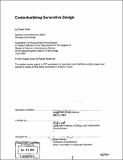| dc.contributor.advisor | Terry Knight. | en_US |
| dc.contributor.author | Arida, Saeed, 1977- | en_US |
| dc.contributor.other | Massachusetts Institute of Technology. Dept. of Architecture. | en_US |
| dc.date.accessioned | 2005-06-02T19:10:40Z | |
| dc.date.available | 2005-06-02T19:10:40Z | |
| dc.date.copyright | 2004 | en_US |
| dc.date.issued | 2004 | en_US |
| dc.identifier.uri | http://hdl.handle.net/1721.1/17917 | |
| dc.description | Thesis (S.M.)--Massachusetts Institute of Technology, Dept. of Architecture, 2004. | en_US |
| dc.description | Includes bibliographical references (p. 107-[110]). | en_US |
| dc.description.abstract | Generative systems have been widely used to produce two- and three-dimensional constructs, in an attempt to escape from our preconceptions and pre-existing spatial language. The challenge is to use this mechanism in real-world architectural contexts in which complexity and constraints imposed by the design problem make it difficult to negotiate between the emergent output, the context, and the controllability desired by the human designer. This thesis investigates how generative systems address contextual parameters, including the designer, client, user, meaning, aesthetics, environment, and function. This is demonstrated through my case studies, in which my aim was to avoid computerized unprocessed formalism that does not implicitly allow for any contextual and cultural content. I sought to extend simple algorithmic form-generation processes to allow for the subtleties of a given context to be effectively addressed. Some challenges and questions arose from these case studies. By interrogating different generative machines, common threads and challenges, similar to mine encountered in the case studies, were found. All of the processes that strove towards the creation of a generative system struggled with similar issues: How can we use rule-based systems without sacrificing meaning or function or the humanistic touch? How can we address contextual parameters without a loss? | en_US |
| dc.description.statementofresponsibility | by Saeed Arida. | en_US |
| dc.format.extent | 109, [1] p. | en_US |
| dc.format.extent | 6134721 bytes | |
| dc.format.extent | 6134527 bytes | |
| dc.format.mimetype | application/pdf | |
| dc.format.mimetype | application/pdf | |
| dc.language.iso | eng | en_US |
| dc.publisher | Massachusetts Institute of Technology | en_US |
| dc.rights | M.I.T. theses are protected by copyright. They may be viewed from this source for any purpose, but reproduction or distribution in any format is prohibited without written permission. See provided URL for inquiries about permission. | en_US |
| dc.rights.uri | http://dspace.mit.edu/handle/1721.1/7582 | |
| dc.subject | Architecture. | en_US |
| dc.title | Contextualizing generative design | en_US |
| dc.type | Thesis | en_US |
| dc.description.degree | S.M. | en_US |
| dc.contributor.department | Massachusetts Institute of Technology. Department of Architecture | |
| dc.identifier.oclc | 56770153 | en_US |
